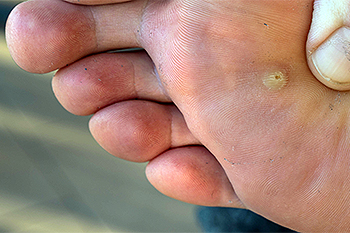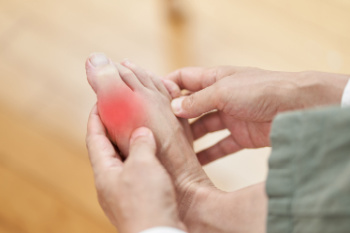1648 US Highway 130
North Brunswick, NJ 08902

Plantar warts are small growths caused by the human papillomavirus, or HPV, that typically develop on the soles of the feet. They often appear as rough, grainy lesions with tiny black dots, which are clotted blood vessels. Symptoms can include discomfort or pain when walking or standing, especially if the wart is located over a weight-bearing area like the heel or ball of the foot. Plantar warts spread through direct contact with the virus, thriving in warm, moist environments like communal showers or swimming pools. The virus can enter the body through small cuts or breaks in the skin. Individuals with weakened immune systems or who walk barefoot in public places are more susceptible. If you have developed a plantar wart, it is suggested that you consult a podiatrist who can effectively treat this condition, which often includes in-office treatment.
Plantar warts can be very uncomfortable. If you need your feet checked, contact Dr. Robert Fink from Brunswick Foot & Ankle Group. Our doctor will assist you with all of your foot and ankle needs.
About Plantar Warts
Plantar warts are the result of HPV, or human papillomavirus, getting into open wounds on the feet. They are mostly found on the heels or balls of the feet.
While plantar warts are generally harmless, those experiencing excessive pain or those suffering from diabetes or a compromised immune system require immediate medical care. Plantar warts are easily diagnosed, usually through scraping off a bit of rough skin or by getting a biopsy.
Symptoms
Treatment
To help prevent developing plantar warts, avoid walking barefoot over abrasive surfaces that can cause cuts or wounds for HPV to get into. Avoiding direct contact with other warts, as well as not picking or rubbing existing warts, can help prevent the further spread of plantar warts. However, if you think you have developed plantar warts, speak to your podiatrist. He or she can diagnose the warts on your feet and recommend the appropriate treatment options.
If you have any questions please feel free to contact our office located in North Brunswick, NJ . We offer the newest diagnostic and treatment technologies for all your foot and ankle needs.

A sprained ankle occurs when the ligaments that support the ankle joint are stretched or torn, usually due to sudden twists or falls. Symptoms can include pain, swelling, bruising, and difficulty bearing weight on the affected foot. Immediate relief tips for a sprained ankle include rest, compression, and elevation. Resting the ankle prevents further injury, while compression with an elastic bandage helps control swelling, and elevating the ankle above heart level minimizes fluid buildup. If you have sprained your ankle, it is suggested that you promptly schedule an appointment with a podiatrist who can offer treatment methods for this painful condition.
Although ankle sprains are common, they aren’t always minor injuries. If you need your ankle injury looked at, contact Dr. Robert Fink from Brunswick Foot & Ankle Group. Our doctor can provide the care you need to keep you pain-free and on your feet.
How Does an Ankle Sprain Occur?
Ankle sprains are the result of a tear in the ligaments within the ankle. These injuries may happen when you make a rapid shifting movement while your foot is planted. A less common way to sprain your ankle is when your ankle rolls inward while your foot turns outward.
What Are the Symptoms?
Preventing a Sprain
Treatment of a Sprain
In many cases, the RICE method (Rest, Ice, Compression, and Elevate) is used to treat ankle sprains. However, you should see a podiatrist to see which treatment option would work best with your injury. In severe cases, surgery may be required.
It is important to ask your doctor about rehab options after you receive treatment for your injury. Stretching, strength training, and balance exercises may help the ankle heal while also preventing further injury.
If you have any questions, please feel free to contact our office located in North Brunswick, NJ . We offer the newest diagnostic and treatment technologies for all your foot care needs.

Diabetic patients face several risk factors that can impact foot health, including poor circulation and high blood sugar levels that can lead to nerve damage. Preventing nerve damage involves maintaining good blood sugar control through a balanced diet, regular exercise, and prescribed medications. Regular foot care is essential for diabetic patients to prevent complications. Daily inspections of the feet for cuts, blisters, or any signs of infection are crucial. Keeping the feet clean and moisturized helps prevent dryness and cracking. Wearing properly fitted shoes reduces the risk of pressure sores and injuries. Additionally, regular check-ups with a podiatrist ensures early detection and treatment of any foot issues. If you have diabetes, it is strongly suggested that you are under the care of this foot doctor who can help you to manage this condition.
Diabetic foot care is important in preventing foot ailments such as ulcers. If you are suffering from diabetes or have any other concerns about your feet, contact Dr. Robert Fink from Brunswick Foot & Ankle Group. Our doctor can provide the care you need to keep you pain-free and on your feet.
Diabetic Foot Care
Diabetes affects millions of people every year. The condition can damage blood vessels in many parts of the body, especially the feet. Because of this, taking care of your feet is essential if you have diabetes, and having a podiatrist help monitor your foot health is highly recommended.
The Importance of Caring for Your Feet
Patients with diabetes should have their doctor monitor their blood levels, as blood sugar levels play such a huge role in diabetic care. Monitoring these levels on a regular basis is highly advised.
It is always best to inform your healthcare professional of any concerns you may have regarding your feet, especially for diabetic patients. Early treatment and routine foot examinations are keys to maintaining proper health, especially because severe complications can arise if proper treatment is not applied.
If you have any questions please feel free to contact our office located in North Brunswick, NJ . We offer the newest diagnostic and treatment technologies for all your foot and ankle needs.
 Gout and bunions are distinct foot conditions that can sometimes be confused due to similar symptoms of pain and swelling in the big toe area. Gout is a form of inflammatory arthritis caused by the accumulation of uric acid crystals in the joint, leading to sudden, severe pain, redness, and swelling. It often affects the big toe but can occur in other joints. Bunions are structural deformities where the big toe deviates toward the other toes, causing a bony bump on the side of the foot. This can result from wearing tight shoes, genetic factors, or arthritis. Bunions can cause chronic pain, especially while walking or wearing shoes, and can lead to swelling and redness. To manage gout, lifestyle changes such as reducing alcohol and purine-rich foods, staying hydrated, and taking medications to lower uric acid levels are recommended. Bunions may be managed with properly fitting shoes, orthotics, and, in severe cases, surgery. If you have toe pain, it is suggested that you schedule an appointment with a podiatrist for an accurate diagnosis and appropriate treatment plan for either condition.
Gout and bunions are distinct foot conditions that can sometimes be confused due to similar symptoms of pain and swelling in the big toe area. Gout is a form of inflammatory arthritis caused by the accumulation of uric acid crystals in the joint, leading to sudden, severe pain, redness, and swelling. It often affects the big toe but can occur in other joints. Bunions are structural deformities where the big toe deviates toward the other toes, causing a bony bump on the side of the foot. This can result from wearing tight shoes, genetic factors, or arthritis. Bunions can cause chronic pain, especially while walking or wearing shoes, and can lead to swelling and redness. To manage gout, lifestyle changes such as reducing alcohol and purine-rich foods, staying hydrated, and taking medications to lower uric acid levels are recommended. Bunions may be managed with properly fitting shoes, orthotics, and, in severe cases, surgery. If you have toe pain, it is suggested that you schedule an appointment with a podiatrist for an accurate diagnosis and appropriate treatment plan for either condition.
Gout is a foot condition that requires certain treatment and care. If you are seeking treatment, contact Dr. Robert Fink from Brunswick Foot & Ankle Group. Our doctor will treat your foot and ankle needs.
What Is Gout?
Gout is a type of arthritis caused by a buildup of uric acid in the bloodstream. It often develops in the foot, especially the big toe area, although it can manifest in other parts of the body as well. Gout can make walking and standing very painful and is especially common in diabetics and the obese.
People typically get gout because of a poor diet. Genetic predisposition is also a factor. The children of parents who have had gout frequently have a chance of developing it themselves.
Gout can easily be identified by redness and inflammation of the big toe and the surrounding areas of the foot. Other symptoms include extreme fatigue, joint pain, and running high fevers. Sometimes corticosteroid drugs can be prescribed to treat gout, but the best way to combat this disease is to get more exercise and eat a better diet.
If you have any questions please feel free to contact our office located in North Brunswick, NJ . We offer the newest diagnostic and treatment technologies for all your foot and ankle needs.

Metatarsal fractures refer to breaks or cracks in one or more of the five long bones in the foot that connect the ankle to the toes. These fractures often result from direct trauma, overuse, or severe twisting of the foot. Symptoms include pain, swelling, bruising, and difficulty bearing weight. Proper treatment is vital for healing, as improper or delayed treatment can lead to serious consequences. Without appropriate care, metatarsal fractures can result in chronic pain, improper bone healing, and long-term mobility issues. Misaligned bones can cause persistent discomfort and increase the risk of arthritis in the affected joints. Therefore, it is essential to seek prompt attention from a podiatrist, follow prescribed treatment plans, and allow adequate time for healing to prevent complications and ensure a full recovery. If you have believe you have fractured a metatarsal, it is strongly suggested that you visit a podiatrist for a diagnosis and treatment.
A broken foot requires immediate medical attention and treatment. If you need your feet checked, contact Dr. Robert Fink from Brunswick Foot & Ankle Group. Our doctor can provide the care you need to keep you pain-free and on your feet.
Broken Foot Causes, Symptoms, and Treatment
A broken foot is caused by one of the bones in the foot typically breaking when bended, crushed, or stretched beyond its natural capabilities. Usually the location of the fracture indicates how the break occurred, whether it was through an object, fall, or any other type of injury.
Common Symptoms of Broken Feet:
Those that suspect they have a broken foot shoot seek urgent medical attention where a medical professional could diagnose the severity.
Treatment for broken bones varies depending on the cause, severity and location. Some will require the use of splints, casts or crutches while others could even involve surgery to repair the broken bones. Personal care includes the use of ice and keeping the foot stabilized and elevated.
If you have any questions please feel free to contact our office located in North Brunswick, NJ . We offer the newest diagnostic and treatment technologies for all your foot and ankle needs.